
|
Philippines, 15 Dec 2025 |
Home >> News |
 |
||||
|
|
|
|
Macario Villon: The Thinking Fighter Who Thrived Where Instinct Reigns By Emmanuel Rivera, RRT PhilBoxing.com Wed, 26 Feb 2025 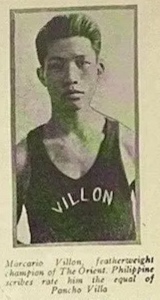 Before the Philippines produced world boxing champions, before Filipino fighters made waves on the international stage, there was Macario Villon. Born Maximiano G. Villon on March 10, 1901, in Balintawak, he knew struggle from an early age. His family lived in a simple nipa hut and it was hard to make ends meet. Despite their circumstances, education remained a priority in the Villon household. He attended San Lazaro Public School, Misericordia Primary, Tondo Intermediate, and Santa Cruz Intermediate then later Mabini Intermediate School, where he finally completed his primary education. Eager to build a better future, he enrolled at the Philippine School of Commerce, studying stenography and bookkeeping. But by 1918, at just 17 years old, he made a life-changing decision. Boxing had already found him, and he chose the ring over the classroom. A Fighter and a Family Man Even as he chased a career in boxing, Villon never lost sight of family. That same year, he married Castora Cruz, a young woman from Santa Cruz, Manila. Still a teenager, he found himself balancing the responsibilities of a husband while trying to make a name for himself as a fighter. Unlike many boxers who squandered their earnings, Villon had foresight. He put his money into land and property, determined to secure a better life for his family. By 1922, he had amassed an estimated P20,000—a remarkable sum at the time. His most significant investment was a spacious P8,000 home, a testament to his discipline and planning. While others spent recklessly, Villon prepared for life beyond the ring. The Sailor Who Became a Fighter At 18, Villon briefly took a different path before fully committing to boxing— he enlisted as a seaman aboard the United States Army Transport (USAT) Thomas. The job was tough, but it gave him something valuable— a chance to see the world and test his skills against foreign competition. Onboard the USAT Thomas, in September 1919, Villon won two matches against American servicemen— one against a marine (TKO 3), the other against an army soldier (KO 1). These victories earned him the respect of his shipmates and reinforced what he already knew— he was born to fight. 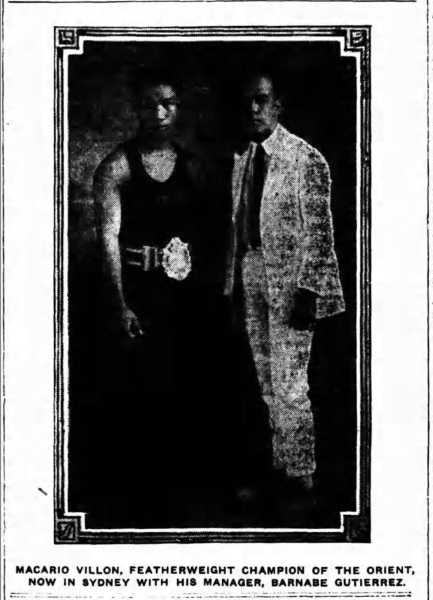
Source: Referee (Sydney, New South Wales, Australia) • Wed, Aug 15, 1923, Page 11 A Filipino Fighter Stuns Australia By 1921, Villon had built a reputation in Manila’s boxing circles, at the biggest stage called Olympic Stadium, but his biggest test awaited him abroad. On April 23, 1921, he traveled to Sydney, Australia, to challenge Jackie Green, the reigning featherweight champion of Australia. Green had experience, home-crowd support, and the championship belt. Villon had only his fists wrapped in Sol Levinson gloves and his heart. But that was enough. In just three rounds, the Filipino knocked Green out cold. The stunned crowd watched as a Filipino fighter came into their territory and took down their champion. Macario Villon was no longer just a local fighter— he was an international contender. A Fighter’s Record: Tough Opponents, Tougher Battles Villon’s professional career spanned nearly a decade (1919–1928), with 28 recorded bouts in the Philippines, Australia, and the United States. His final record—11 wins (5 KOs), 12 losses, and 5 draws— only tells part of the story. 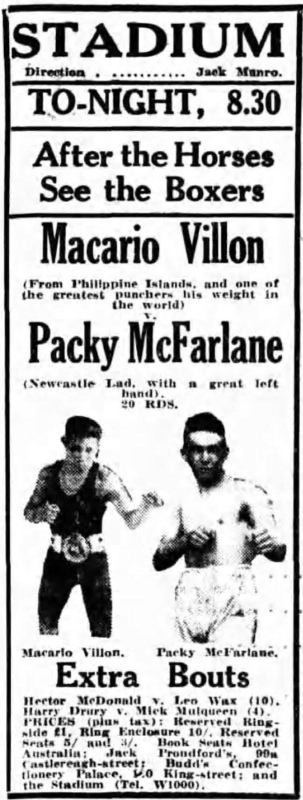
(Sydney, New South Wales, Australia) • Sat, Sep 29, 1923 •page 9 He fought some of the toughest names in the sport, including Bud Ridley, Silvino Jamito, Bert Spargo, and Billy Grime. Among his most memorable wins were a knockout over Packy MacFarlane (1923), and a grueling 20-round decision against Bud Ridley (1922), which Manila fight fans hailed as one of the greatest battles they had ever seen. But time is undefeated. Early in his career, according to his manager Bernabe Concepcion, Villon had two fights at the Dreamland Rink which he won by knockout, in the first round each, though these fights do not show on Villon’s official record, they are referenced on BoxRec.com. His opponents were Bill Caddy (against a Young Macario, Garibaldi Hall, San Francisco on December 30, 1919, BoxRec) and Jack O'Keefe (against a Max Villion, Dreamland Rink, San Francisco on April 30, 1920, BoxRec). In the twilight of Villon’s career, his second-to-last fight was a 2-round TKO loss to Frankie Warren in San Francisco on June 2, 1925, signaling that his best days were behind him. His final recorded bout, on April 20, 1928, ended in a TKO loss to Jose Nieves in San Juan, Puerto Rico. At 27 years old, he stepped away from the sport, or so his official record showed. 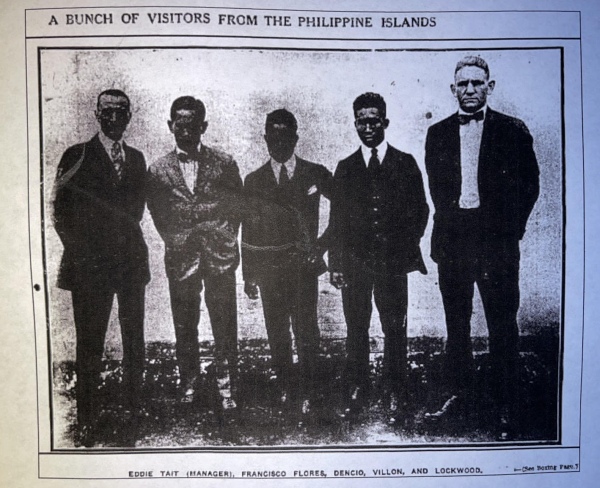
Source: The Referee • Wed, Feb 09, 1921 • Page 14 • (Sydney, New South Wales, Australia) Villon’s journey in boxing was more than just personal success— it was also about camaraderie. He formed a deep bond with Gaudencio “Kid Dencio” Cabanela, the best Filipino boxer according to the founders of Philippine boxing— Frank Churchill, Stewart and Edwin Tait, Joe Waterman and Bill Miller. The two trained together, fought side by side, and represented the strength of Filipino boxing abroad. When Kid Dencio tragically passed away in Australia after a brutal fight against Bert McCarthy on July 2, 1921, Villon was devastated. He stood by his fallen friend— helping bring his mortal remains back home to Manila, speaking at his funeral, and ensuring that Dencio’s legacy was honored. The streets overflowed with mourners as the boxing community and everyday during funeral ceremonies Filipinos paid their last respects. For Villon, it wasn’t just about fights won or titles held— it was about brotherhood, loyalty, and remembering those who paved the way. An Unfinished Chapter What happened to Macario Villon after boxing? That part of his life remains unknown. Unlike his fights, which were covered in newspapers from Manila to Sydney, his post-boxing years faded from public record. Like many early Filipino boxing greats, his life after the final bell remains a mystery. Perhaps, through this article, a relative or someone who knew him will come forward, filling in the missing pages of his journey. Until then, we honor the Villon we do know— the fighter who made his mark, whose fists spoke louder than words. 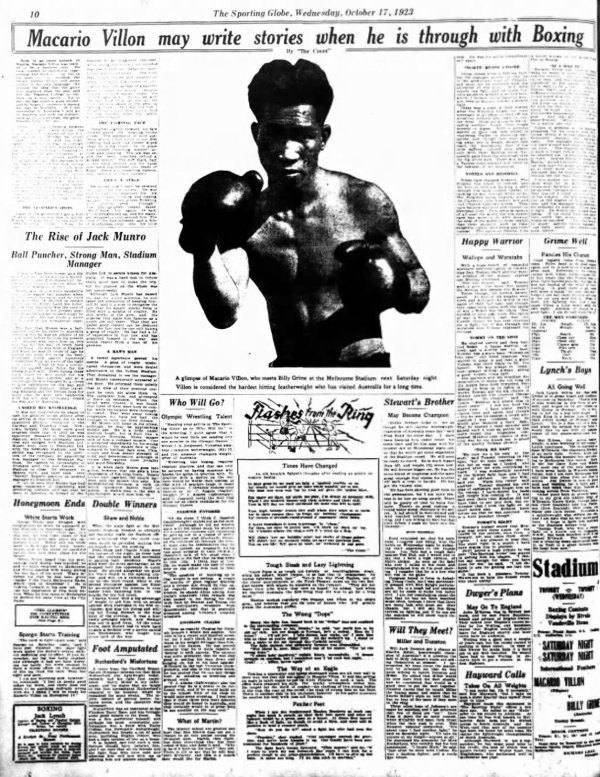
A Legacy That Deserves Recognition Macario Villon was one of the first Filipino fighters to make a name for himself internationally. He defeated regional champions, fought across the world, and inspired a generation of Filipino boxers who followed. Macario Villon’s name deserves to live on— not just as a trailblazing fighter who gave it his all, but as a man with a big heart, unshakable determination, and the tireless work ethic Filipinos are known for. Today, his name has faded from memory. Perhaps it’s time we remember. Sources and Further Readings: • Top Photo of Macario Villon (Source: The Ring, Bible of Boxing, April 1923 (Public Domain) • “Something About The Life of Macario Villon and His Ring Battles”, By Bernabe Gutierrez (Boxing March 11, 1922, Courtesy of the National Library of the Philippines) Mr. Gutierrez’ article will be published in full in our future book • All photos and references are in this article are duly attributed and comply with the the United States Fair Use Doctrine Click here to view a list of other articles written by Emmanuel Rivera, RRT. |
|
|
PhilBoxing.com has been created to support every aspiring Filipino boxer and the Philippine boxing scene in general. Please send comments to feedback@philboxing.com |
PRIVATE POLICY | LEGAL DISCLAIMER
developed and maintained by dong secuya © 2025 philboxing.com. |